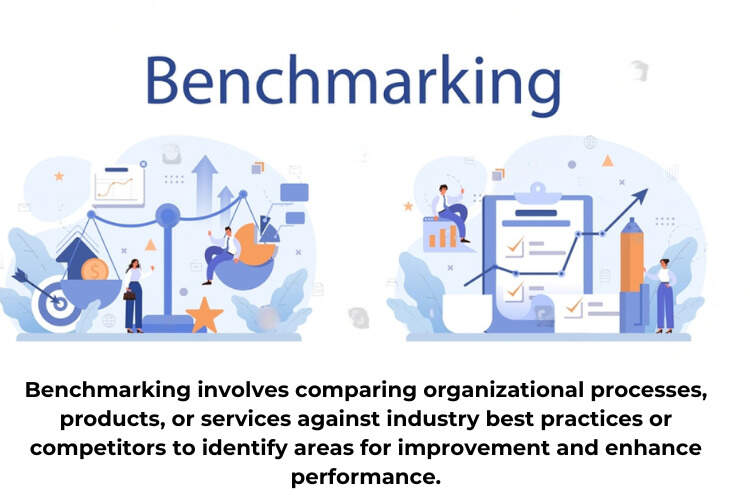
Bench marking purpose of benchmarking analysis in organizational performance improvement.
Importance of benchmarking for identifying best practices and areas for improvement.
Types of Bench marking
Internal benchmarking: Comparing performance metrics within different departments or units of the same organization.
Competitive benchmarking: Evaluating performance against industry peers or competitors.
Functional benchmarking: Analyzing performance metrics of similar processes or functions across different industries.
Selection of Bench marking Metrics
Identifying key performance indicators (KPIs) relevant to the benchmarking objectives.
Ensuring that benchmarking metrics are measurable, comparable, and aligned with organizational goals. Establishing baseline performance metrics for comparison accordingly
Data Collection and Analysis
Gathering relevant performance data from internal and external sources accordingly
Conducting thorough analysis to compare performance metrics against benchmarks. Identifying gaps and areas for improvement based on benchmarking results similarly
Practices Identification
Analyzing benchmarking data to identify best practices and successful strategies accordingly
Benchmarking against industry leaders or top performers to learn from their approaches.
Documenting and disseminating best practices for adoption within the organization accordingly
Action Planning and Implementation
Developing action plans to address identified gaps and opportunities for improvement.
Assigning responsibilities and setting timelines for implementing recommended changes.
Similarly ,Monitoring progress and adjusting strategies as needed to achieve desired outcomes.
Continuous Monitoring and Feedback
Establishing mechanisms for ongoing monitoring of performance against benchmarks accordingly
Soliciting feedback from stakeholders to assess the effectiveness of implemented changes.
Iteratively refining benchmarks and performance improvement strategies based on feedback and results.
Bench marking Pitfalls and Challenges
Common pitfalls to avoid in benchmarking analysis, such as selection bias or inadequate data quality.
Challenges in interpreting benchmarking results and applying findings to drive meaningful change accordingly
Strategies for overcoming obstacles and maximizing the value of benchmarking initiatives accordingly
Strategies
Real-world examples of successful benchmarking initiatives in various industries accordingly
Case studies illustrating the impact of benchmarking analysis on organizational performance improvement.
In the same way Lessons learned and key takeaways from benchmarking success stories.
Future Trends in Benchmarking:
In the same way ,emerging trends and technologies shaping the future of benchmarking analysis.
The role of big data, artificial intelligence, and predictive analytics in enhancing benchmarking capabilities accordingly
Opportunities for organizations to leverage benchmarking as a strategic tool for continuous improvement and competitive advantage accordingly
